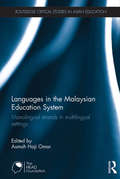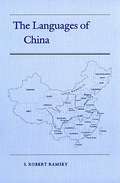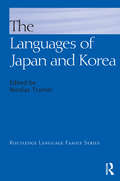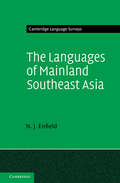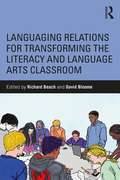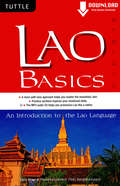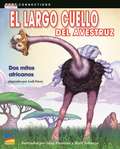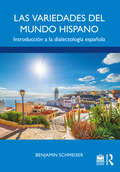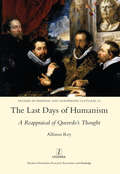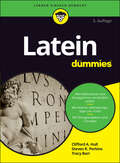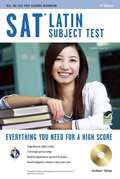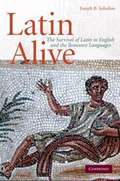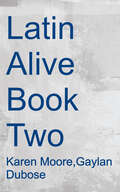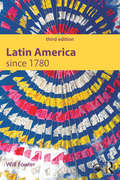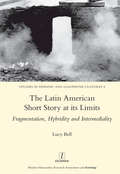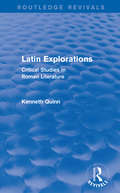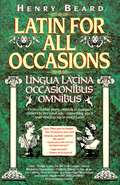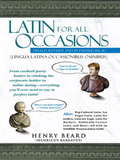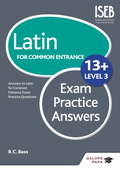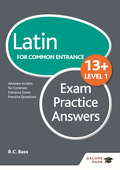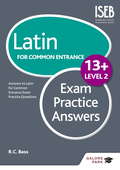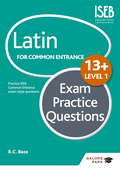- Table View
- List View
Languages in the Malaysian Education System: Monolingual strands in multilingual settings (Routledge Critical Studies in Asian Education)
by Asmah Haji OmarThis book provides an overview of language education in Malaysia, covering topics such as the evolution of the education system from pre-independence days to the present time, to the typology of schools, and the public philosophy behind every policy made in the teaching of languages. The book consists of chapters devoted to the teaching of languages that form separate strands but are at the same time connected to each other within the education system. These chapters discuss: Implementing the national language policy in education institutions English in language education policies and planning in Malaysia Chinese and Tamil language education in Malaysia Teaching of indigenous Malaysian languages The role of translation in education in Malaysia It also discusses the development of language which enables the national language, Malay, to fulfil its role as the main medium of education up to the tertiary level. This book will be of interest to researchers studying language planning, teacher education and the sociology of education, particularly, within the Malaysian context.
The Languages of China
by S. Robert RamseyIn producing a book on China as a linguistic area, the ideal is a comprehensive and accurate account that places China's linguistic diversity in a meaningful historical, geographical, and social context. Ramsey has succeeded admirably in achieving this end. The Languages of China a pleasure in virtually all respects. It is extremely easy to read, full of useful information, and beautifully produced
The Languages of Japan and Korea (Routledge Language Family Ser.)
by Nicolas TranterThe Languages of Japan and Korea provides detailed descriptions of the major varieties of languages in the region, both modern and pre-modern, within a common format, producing a long-needed introductory reference source. Korean, Japanese, Ainu, and representative members of the three main groupings of the Ryukyuan chain are discussed for the first time in a single work. The volume is divided into language sketches, the majority of which are broken down into sections on phonology, orthography, morphology, syntax and lexicon. Specific emphasis is placed on those aspects of syntactic interest, such as speech levels, honorifics and classifiers, which are commonly underplayed in other descriptions of Modern Japanese and Korean. Each language is represented in Roman-based transcription, although its own script (where there is such an orthography) and IPA transcriptions are used sparingly where appropriate. The dialects of both the modern and oldest forms of the languages are given extensive treatment, with a primary focus on the differences from the standard language. These synchronic snapshots are complemented by a discussion of both the genetic and areal relationships between languages in the region.
The Languages of Mainland Southeast Asia: The State Of The Art (Cambridge Language Surveys #649)
by N. J. EnfieldMainland Southeast Asia is one of the most fascinating and complex cultural and linguistic areas in the world. This book provides a rich and comprehensive survey of the history and core systems and subsystems of the languages of this fascinating region. Drawing on his depth of expertise in mainland Southeast Asia, Enfield includes more than a thousand data examples from over a hundred languages from Cambodia, China, Laos, Malaysia, Myanmar, Thailand, and Vietnam, bringing together a wealth of data and analysis that has not previously been available in one place. Chapters cover the many ways in which these languages both resemble each other, and differ from each other, and the diversity of the area's languages is highlighted, with a special emphasis on minority languages, which outnumber the national languages by nearly a hundred to one. The result is an authoritative treatment of a fascinating and important linguistic area.
Languaging Relations for Transforming the Literacy and Language Arts Classroom
by Richard Beach David BloomeApplying a languaging perspective, this volume frames the teaching and learning of literacy, literature, language, and the language arts as social and linguistic actions that generate new questions to make visible social, cultural, psychological, linguistic, and educational processes. Chapter authors explore diverse aspects of a languaging framework, the perspective of language as a series of ongoing and evolving interactional social actions and processes over time. Based on their research, the authors suggest directions for addressing substantive engagement as well as the marginalization, superficiality, and violence (symbolic and otherwise) that characterize the educational experience of so many students. Responding to the need to foster and support students’ intellectual, social, and affective worlds, this book showcases how languaging relations among teachers and students can deepen interactions and engagement with texts; enhance understandings of agency, personhood, and power relations in order to transform literacy, literature, and language arts classrooms; and improve the lives of teachers and students in educational settings.
Lao Basics: An Introduction to the Lao Language
by Phouphanomlack Tee Sangkhampone Sam BrierThis is a concise, do-it- yourself guide to the Lao languageLao Basics teaches conversational Lao from the very beginning with an emphasis on reading and writing. <P><P>Students of Thai will find Lao quite simple, as much of these two languages are the same or very similar. These languages derive from Sanskrit and share many of the same consonants, vowels, vocabulary and grammar. Lao Basics is organized so that you first learn to read Lao, write Lao, speak Lao and comprehend the 26 consonants in their tonal classes. Once you have mastered these you will study the 28 vowels in subsets. Within each vowel grouping, you will learn vocabulary, conversational phrases, alphabetical order and sentence structure through exercises that grow more challenging as your vocabulary increases.As you progress through Lao Basics, vocabulary from previous lessons will be repeated regularly and our command of the written and spoken language will steadily improve. And you can do all this on your own. Each chapter's Lao words and exercises have been recorded on the accompanying MP3 audio-CD, and all of the exercises answers are in the back of the book.Highlights of this book are: Throughout, review exercises with answer keys help you polish your skills. The vocabulary and phrases are written in Lao script, and are accompanied by pronunciations that help English speakers to say them accurately. The MP3 audio CD includes every vocabulary item, sample phrases, and exercises, so that you can learn from native voices.
El largo cuello del avestruz: Dos Mitos Africanos (Text Connections)
by Lesli Favor Gary Freeman Matt Johnson Lori O'DeaNIMAC-sourced textbook
Las variedades del mundo hispano: Introducción a la dialectología española
by Benjamin SchmeiserLas variedades del mundo hispano tiene un acercamiento nuevo a la dialectología española, ya que guía a los estudiantes por las macrovariedades fascinantes y diversas del mundo hispano. Un libro de texto único escrito en español que ofrece una introducción atractiva y accesible a la dialectología española, sus ámbitos claves incluyen: la cobertura de España, Sudamérica, Centroamérica, y Norteamérica; el libro de texto contiene una mezcla ideal de teoría y práctica; secciones de Práctica que contienen ejercicios para reforzar el aprendizaje; e incluye actividades que invitan a los estudiantes a explorar materiales de video y audio en el sitio web que acompaña el libro de texto. Además, el libro de texto incluye un componente de redes sociales que deja que los estudiantes aprendan en un formato que ha sido poco utilizado en cursos universitarios. Aunque principalmente fue diseñado para estudiantes de dialectología y fonética, tanto a nivel subgraduado como graduado, también sería una fuente invaluable para otros cursos de la lingüística hispánica al nivel universitario. Las variedades del mundo hispano takes a refreshing approach to Spanish dialectology, guiding students through the fascinating and diverse macro varieties of the Spanish-speaking world. A unique textbook written in Spanish and offering an engaging and accessible introduction to Spanish dialectology, its key features include: coverage of Spain, South, Central and North America; the ideal balance between theory and practice; a companion website with extensive audio and video materials for students to interact with; Práctica sections with exercises to reinforce learning; and a social media element that offers insight into a format often under-utilized in university courses. Though designed primarily for students of Spanish dialectology and phonetics at both undergraduate and graduate levels, Las variedades del mundo hispano would also prove an invaluable resource for a wide range of Spanish linguistics courses.
Lasai, ez da ezer gertatzen
by Ana Malagon ZalduaBakardadearen mapa moduko bat da liburu hau, Iban Zalduak hitzaurrean dioenez. Frustrazioaren koordenadak erakusten dizkigu bere orrietan, insatisfazioaren eta inkomunikazioaren kartografia. 162 mikroipuin idatzi ditu egileak, inoiz orria gainditu gabe, eta neurri murritz horretan unibertso pertsonal bat eraiki du: hiritarra, gaurkoa, gure egunerokotasunari ironiazko begirada bat eskaintzen diona. Haurtzaroa ageri da kontakizunotan, ez idealizatua baizik porrot txikiz osatua; heriotza ez tragikoa baizik eta ia etxekoa, misteriotsu baina aldi berean irrigarria; maitasun ez poz betezko baizik ahitua, askotan jaio orduko usteldua. Idazkera sobrio eta zehatza darabil Malagonek, apaingarriei eta enfasiei ihes egiten diena, eta ?bistan denez? luzamendutan galtzen ez dena.
The Last Days of Humanism: A Reappraisal of Quevedo's Thought
by Alfonso ReyFrancisco de Quevedo (Madrid, 1580-1645) was well known for his rich and dynamic style, achieved through an ingenious and complex manipulation of language. Yet he was also a consistent and systematic thinker, with moral philosophy, broadly understood, lying at the core of his numerous and varied works. Quevedo lived in an age of transition, with the Humanist tradition on the wane, and his writing expresses the characteristic uncertainty of a moment of cultural transition. In this book Alfonso Rey surveys Quevedo's ideas in such diverse fields as ethics, politics, religion and literature, ideas which hitherto have received little attention. New information is also provided towards a reconstruction of the cultural evolution of Europe in the years prior to the Enlightenment, and thus the scope of the book extends beyond that of Spanish literature.
Latein für Dummies (Für Dummies)
by Clifford A. Hull Steven R. Perkins Tracy L. BarrLatein lernen einmal anders. Die Autoren von "Latein für Dummies" zeigen Ihnen, wie man mit Spaß Latein lernen, auffrischen oder verbessern kann. Zwischen Konjugationen und Deklinationen erfahren Sie viel über die römische Gesellschaft, Literatur und über das, was Latein auch heute noch für uns interessant macht. Mit einem kleinen Wörterbuch und vielen Konjugations- und Deklinationstabellen sowie Übungen samt Lösungen ist dies der ideale Einsteiger- und Auffrischungskurs für die Lateiner von morgen.
Latin
by Jurgen LeonhardtThe mother tongue of the Roman Empire and the lingua franca of the West for centuries after Rome's fall, Latin survives today primarily in classrooms and texts. Yet this "dead language" is unique in the influence it has exerted across centuries and continents. Jürgen Leonhardt has written a full history of Latin from antiquity to the present, uncovering how this once parochial dialect developed into a vehicle of global communication that remained vital long after its spoken form was supplanted by modern languages. Latin originated in the Italian region of Latium, around Rome, and became widespread as that city's imperial might grew. By the first century BCE, Latin was already transitioning from a living vernacular, as writers and grammarians like Cicero and Varro fixed Latin's status as a "classical" language with a codified rhetoric and rules. As Romance languages spun off from their Latin origins following the empire's collapse--shedding cases and genders along the way--the ancient language retained its currency as a world language in ways that anticipated English and Spanish, but it ceased to evolve. Leonhardt charts the vicissitudes of Latin in the post-Roman world: its ninth-century revival under Charlemagne and its flourishing among Renaissance writers who, more than their medieval predecessors, were interested in questions of literary style and expression. Ultimately, the rise of historicism in the eighteenth century turned Latin from a practical tongue to an academic subject. Nevertheless, of all the traces left by the Romans, their language remains the most ubiquitous artifact of a once peerless empire.
Latin (SAT PSAT ACT (College Admission) Prep Series)
by Ronald B. Palma<P>Taking the SAT Latin Subject Test? <P>Then REA's SAT Subject Test: Latin Test Prep with Practice Tests on CD is just for you! <P>Written by an experienced Latin teacher, this second edition of our bestselling SAT Subject Test: Latin test prep includes a comprehensive review of covers all language areas appearing on the actual exam including coverage of declensions, conjugations, sentence structure, and more. Each chapter contains numerous examples and practice questions, and tips that help students study smarter and boost their test scores. <P>The book includes two full-length practice tests that replicate the actual exam's question format. Both of the book's practice exams are featured on our TestWare CD with the most powerful scoring and diagnostic tools available today. Automatic scoring and instant reports help you zero in on the topics and types of questions that give you trouble now, so you'll succeed when it counts. <P>Detailed explanations of answers help you identify your strengths and weaknesses. We don't just say which answers are right - we also explain why the other answer choices are incorrect - so you'll be prepared on test day. <P>The book also includes study tips, strategies, and confidence-boosting advice you need for test day. <P>REA's test prep is a must for any high school student taking the SAT Latin Subject Test!
Latin Alive: The Survival of Latin in English and the Romance Languages
by Joseph B. SolodowIn Latin Alive, Joseph Solodow tells the story of how Latin developed into modern French, Spanish, and Italian, and deeply affected English as well. Offering a gripping narrative of language change, Solodow charts Latin's course from classical times to the modern era, with focus on the first millennium of the Common Era. Though the Romance languages evolved directly from Latin, Solodow shows how every important feature of Latin's evolution is also reflected in English. His story includes scores of intriguing etymologies, along with many concrete examples of texts, studies, scholars, anecdotes, and historical events; observations on language; and more. Written with crystalline clarity, this is the first book to tell the story of the Romance languages for the general reader and to illustrate so amply Latin's many-sided survival in English as well.
Latin Alive! Book Two
by Karen Moore Gaylan DuboseLatin Alive! Book 2 continues the relevant, rigorous, and incremental Latin instruction begun in Latin Alive! Book 1. The series is designed to make Latin come alive for middle and high school students, showing the relevance and power of Latin in history, ancient and contemporary culture, the Romance languages, English derivatives, and the grammatical structure of English. It also features original Latin writings, giving students access to the works of great Latin authors in their original tongue. As the second text in a three-year series, Latin Alive! Book 2 is an entry point to advanced grammatical studies, and also includes considerable review.
Latin America since 1780
by Will FowlerLatin America since 1780 provides an accessible introductory text aimed at Spanish linguists and historians taking modules in Latin American history. It provides a compelling continental-based historical narrative supported throughout by incisive evaluation, pedagogical features, and authentic source texts in the original Spanish. This book focuses on key events such as the Wars of Independence, the Mexican, Cuban and Sandinista Revolutions, and the recent shift to the left, as well as providing short inserts on the main political protagonists such as Simon Bolívar, Getulio Vargas and Hugo Chávez. The 3rd edition has been revised in line with crucial recent political, cultural and economic developments. It offers an entirely new chapter covering the key events and issues of the 21st century, fresh topics for essays and presentations, increased attention to literary, ethnic and social culture and a new e-resource offering English translations of Spanish sources.
The Latin American Short Story at its Limits: Fragmentation, Hybridity and Intermediality
by Lucy BellThe Latin American short story has often been viewed in terms of its relation to orality, tradition and myth. But this desire to celebrate the difference of Latin American culture unwittingly contributes to its exoticization, failing to do justice to its richness, complexity and contemporaneity. By re-reading and re-viewing the short stories of Juan Rulfo, Julio Cortazar and Augusto Monterroso, Bell reveals the hybridity of this genre. It is at once rooted in traditional narrative and fragmented by modern experience; its residual qualities are revived through emergent forms. Crucially, its oral and mythical characteristics are compounded with the formal traits of modern, emerging media: photography, cinema, telephony, journalism, and cartoon art.
Latin Explorations: Critical Studies in Roman Literature (Routledge Revivals)
by Kenneth QuinnLatin Explorations, first published in 1963, offers a fresh approach to Roman poetry from Catullus to Ovid. Traditionally, the period is divided for specialist studies – Lyric, Epic and Elegy. In each of them, techniques of interpretation prevail, isolated from contemporary ideas about poetry and dominated by barriers between ‘textual’, ‘exegetical’ and ‘aesthetic’ criticism. Kenneth Quinn discerns in Roman poetry of this period the adolescence, maturity and decay of a single coherent tradition whose internal unity surpasses differences of form. His argument attempts to reverse the dissociation of purely academic research from appreciative criticism, whilst also incorporating the work of textual scholars. Each chapter is supported by a detailed analysis of the texts: nearly 700 lines of poetry are discussed and translated. Latin Explorations will be of significant value not only to students of the Classics, but also to the ‘Latinless’ general reader who is interested in Roman literature.
Latin for All Occasions: Lingua Latina Occasionibus Omnibus
by Henry BeardHundreds of everyday English expressions rendered into grammatically accurate, idiomatically correct classical Latin, with pronunciation guide.
Latin for All Occasions
by Henry BeardWith more than 200,000 copies in print, Latin for All Occasions and its follow-up, Latin for Even More Occasions, have helped scores of readers harness the language of Caesar and Cicero. Impress your boss with Occupational Latin (Lingua Latina Occupationi); sell your product with Sales Latin (Lingua Latina Mercatoria); flirt with your classics professor with Sensual Latin (Lingua Latina Libidinosa); look like the hipster you are with Pop-Cultural Latin (Lingua Latina Popularis); survive the holidays with Familial Latin (Lingua Latina Domestica) and Celebrational Latin (Lingua Latina Festiva). It’s all here, whether you’re a student of the language or just want to talk like one. From cocktail-party banter to climbing the corporate ladder to online dating, Latin for All Occasions features dozens of handy sections, including Las Vegas Latin, Latin for Golfers, Latin for Breakups, Latin for the Politically Correct, and much, much more. In one easy-to-use volume, National Lampoon founder Henry Beard presents hundreds of listings rendered in grammatically accurate classical Latin, with a foolproof pronunciation guide. Who says Latin is a dead language? From the comic genius who brought us X-Treme Latin comes Latin for All Occasions, guaranteed to help readers delight their friends, insult their enemies, and elevate the public discourse. .
Latin for Common Entrance 13+ Exam Practice Answers Level 1
by Bob BassThis book contains comprehensive answers and a suggested mark scheme to the exercises in Latin for Common Entrance 13+ Exam Practice Questions Level 1. - Endorsed by ISEB- Contains both the Latin and English translations to save you time marking work and to help identify areas that require further study- Includes answers for all exercises so that pupils understand how full their responses need to be to achieve top marks
Latin for Common Entrance 13+ Exam Practice Answers Level 1
by R. C. BassExam Board: ISEBLevel: 13+Subject: LatinFirst Teaching: September 2014First Exam: Autumn 2015This book contains comprehensive answers and a suggested mark scheme to the exercises in Latin for Common Entrance 13+ Exam Practice Questions Level 1- Endorsed by ISEB- Contains both the Latin and English translations to save you time marking work and to help identify areas that require further study- Includes answers for all exercises so that pupils understand how full their responses need to be to achieve top marks
Latin for Common Entrance 13+ Exam Practice Answers Level 2
by R. C. BassThis book contains comprehensive answers and a suggested mark scheme to the exercises in Latin for Common Entrance 13+ Exam Practice Questions Level 2. - Endorsed by ISEB- Contains both the Latin and English translations to save you time marking work and to help identify areas that require further study- Includes answers for all exercises so that pupils understand how full their responses need to be to achieve top marks
Latin for Common Entrance 13+ Exam Practice Questions Level 1
by R. C. BassThis set of exam-style questions provides pupils with a wealth of practice for 13+ ISEB Latin Common Entrance exams at Level 1. The huge range of questions covers translation, grammar and vocabulary, enabling pupils to familiarise themselves with the types of questions they will face in the real exam. - Endorsed by ISEB- Prepares pupils for Latin Common Entrance and Level 1 entrance exams- Features extensive practice in comprehension and translation both from English to Latin and Latin to English- Includes a complete vocabulary list for Level 1 to serve as a checklist for pupils
Latin for Common Entrance 13+ Exam Practice Questions Level 1 (for the June 2022 exams)
by R. C. BassPlease note, this resource is suitable for the exams up to June 2022. New revision resources will be available from Spring 2022 for the exams from November 2022.Exam Board: ISEBLevel: 13+Subject: LatinFirst Teaching: September 2014First Exam: Autumn 2015This set of exam-style questions provides pupils with a wealth of practice for 13+ ISEB Latin Common Entrance exams at Level 1. The huge range of questions covers translation, grammar and vocabulary, enabling pupils to familiarise themselves with the types of questions they will face in the real exam- Endorsed by ISEB- Prepares pupils for Latin Common Entrance and Level 1 entrance exams- Features extensive practice in comprehension and translation both from English to Latin and Latin to English- Includes a complete vocabulary list for Level 1 to serve as a checklist for pupils
